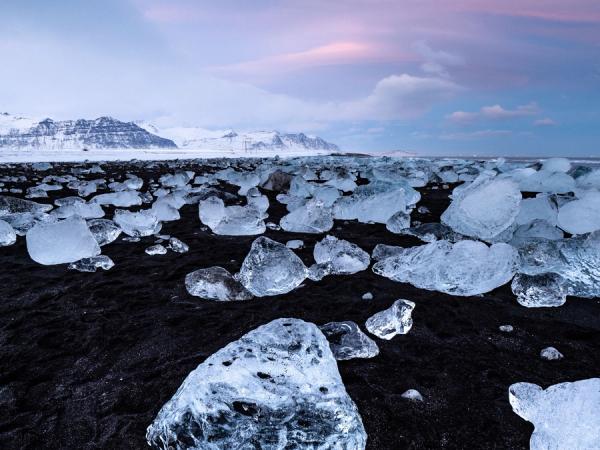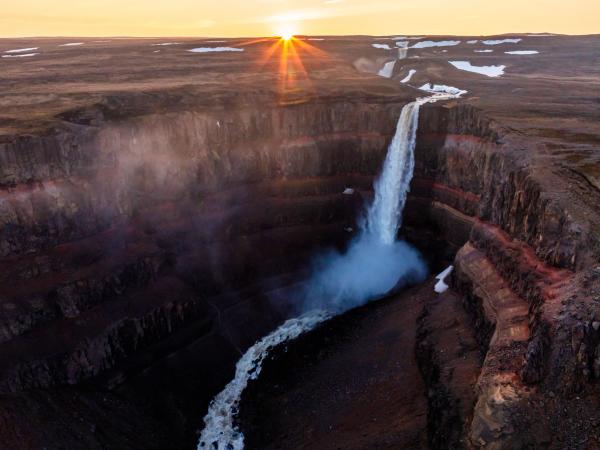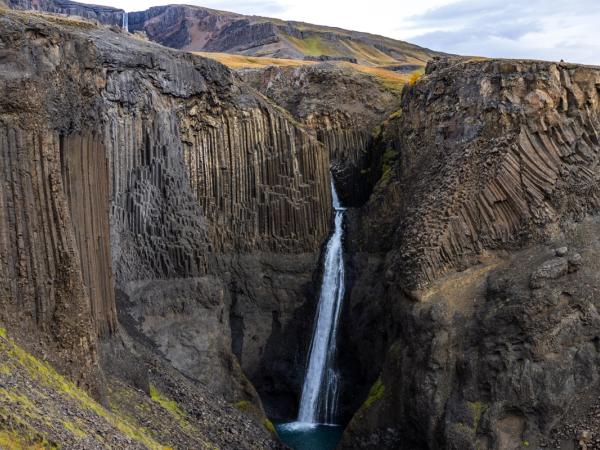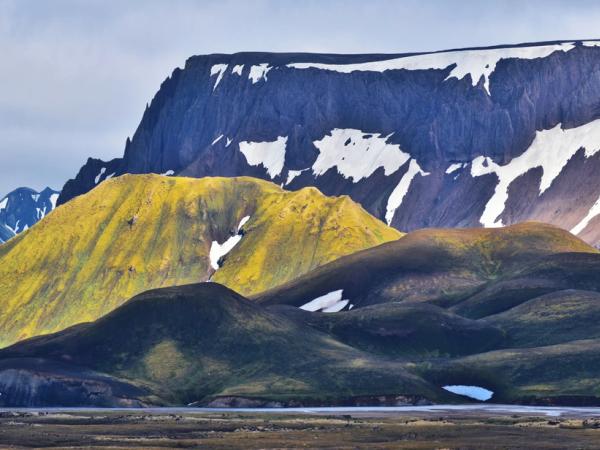
A Treasure Chest: Iceland's Top 20 Natural Wonders
There are not many places in the world that have so many amazing places packed in a relatively small territory as Iceland has. The whole country is like a natural museum, a collection of natural wonders that often leave visitors completely speechless. The unique geological and geographical features in the country are so many, so varied, so unique, that it’s very difficult to classify them.
The island is like a treasure chest, full of jewels, all beautiful and different. And they are all worth a visit. For this reason, Iceland has become a top destination for travelers looking for some of the best natural monuments there are in the world. And there are so many of them that many people repeat the experience, as they couldn’t fit everything in their first visit to this majestic Nordic country.
In this humble guide, we’ve selected some of the best things Iceland has waiting for you. The list could go on and on. For instance, Iceland has three amazing national parks, and we’ve described them here as a whole, but they all have many different attractions that could be listed separately. But if you’re deciding what to see when you come, we hope we can help you out. Come with us to discover some of the best things to see here.
Key Takeaways
- Iceland has a huge variety of natural attractions: waterfalls, volcanoes, lava fields, glaciers, ice caves, and lagoons.
- Some of the attractions can be grouped together as a part of a scenic route, like the Golden Circle or the Diamond Circle.
- The three national parks in Iceland are listed here as a whole, but each one of them is a collection of natural wonders.
1. Þingvellir National Park
Located in the southwest of the country, not far from Reykjavik, Þingvellir -which can also be spelled Thingvellir- is a UNESCO World Heritage Site. This park is not only a series of natural wonders but also a place with a crucial role in Iceland’s history. Here is where the Alþingi, the country’s parliament and oldest parliament in the world, first gathered in the year 930.
Þingvellir is located on the division between the Eurasian and North American tectonic plates, which means that Iceland is technically on two continents. This can be seen in the Sifra Fissure, where you can swim and touch both plates at the same time, or in the Almannagjá Gorge above ground.
Other amazing places here are Öxarárfoss Waterfall and Þingvallavatn Lake, among many others.

2. Gullfoss
Gullfoss is one of Iceland’s most iconic waterfalls. It’s a two-tiered drop that falls 32 meters (105 feet) into a rugged canyon. The name translates as “Golden Falls” -foss meaning waterfall in Icelandic- because of the colorful effect created when the sun is out and touches the mist created by the waterfall.

3. Geysir Geothermal Area
This is the third major and final stop of the Golden Circle after Þingvellir National Park and Gullfoss. This vast field is one of the best examples of the geothermal and volcanic activity that happens below the surface in Iceland. The Geysir Geothermal Area is full of geysers and hot springs.
The Great Geysir shoots water up to 38 meters (122 feet), but its eruptions are rare. On the other hand, the Stokkur Geysir erupts every 5 to 10 minutes, and the water can reach up to 20 meters (65 feet).

4. Vatnajökull National Park
This park is the largest national park in Europe, and it covers 14% of Iceland’s territory. The most important feature is the glacier that gives the park its name, and it’s also the biggest glacier on the continent. The park is characterized by its constant interaction between fire and ice, as there’s volcanic activity happening underneath the ice, creating unique formations and anomalies.
Vatnajökull National Park is famous for its ice caves, which are created during the winter months. So, each year, these caves are different. They can be visited with a guided tour. The park is also home to several waterfalls and a huge diversity of flora and fauna.
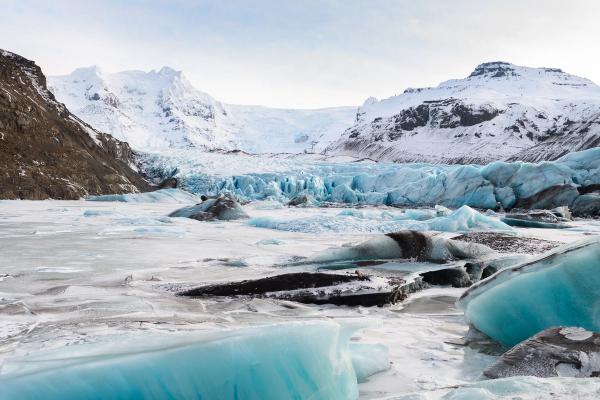
5. Snæfellsjökull National Park
Snæfellsjökull National Park, the third national park in the country, is the only one that includes terrestrial and marine areas. Located in the Snæfellsnes Peninsula, it gets its name from the ice-capped volcano that crowns the region. Apart from being impressive, it’s also a place of literary fame, as the volcano is where Jules Verne placed the entrance to the unknown in "Journey to the Center of the Earth."
The list of things to see in Snæfellsjökull is almost endless. You can see Kirkjufell, the most photographed mountain in Iceland; or the impressive Lóndrangar Basalt Cliffs, a dramatic view full of mystical stories. Other great options are Djúpalónssandur Beach and Vatnshellir Cave, for example. The park is also a great place to see whales and puffins.
6. Dettifoss
This astonishing waterfall, the second most powerful in Europe, is technically part of the Vatnajökull National Park but deserves its own section. It’s also part of the Diamond Circle, a route that connects several of the best things to see in North Iceland.
Nicknamed “The Beast”, Dettifoss is 44 meters (147 feet) high and 100 meters (330 feet) wide. You can view it from both the east and west sides of the river, each offering unique perspectives and experiences. Standing in front of the falls is a humbling experience.

7. Goðafoss
Not far from Dettifoss, we can find this famous waterfall. This one is smaller and more serene but not short of beauty. What strikes me the most about this waterfall is the color, a vivid turquoise hue. The name translates as ‘Waterfall of the Gods’, as it was here where, in the year 1000, law speaker and local chieftain Þorgeir Ljósvetningagoði decided to convert to Christianity.
One of the best things about Goðafoss is that it can be accessed on both sides of the river, each one offering a different perspective.
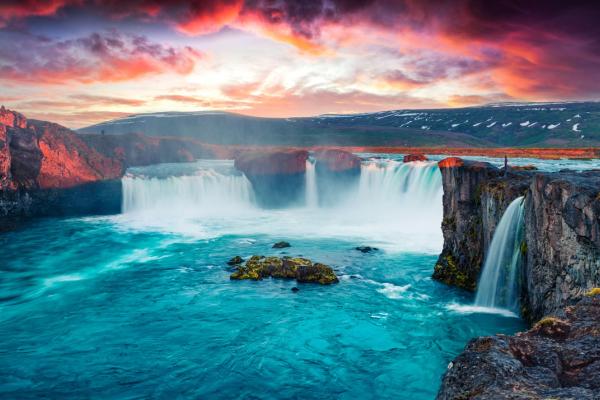
8. Jökulsárlón Glacier Lagoon
Jökulsárlón Glacier Lagoon is one of the most different and unique places to see in Iceland. This lagoon is famous for the big pieces of ice that are floating on the water. These little icebergs have separated from a nearby glacier and can be seen gliding on the lake’s surface before drifting out into the ocean.
Once they get there, many end up on Diamond Beach, where they create a beautiful contrast between the blue ice and the black sand. One of the best things about Jökulsárlón is that it never looks the same, as the pieces of ice are constantly shifting and changing.
8. Skógafoss
Skógafoss is known for its impressive 60-meter (197-foot) drop. It creates a beautiful mist that turns into rainbows when the sun is out. You can get right up close to the waterfall, hearing the roar of the water. It’s a powerful, unforgettable experience.
For a different perspective, climb the stairs next to the falls for a fantastic view of both the waterfall and the surrounding landscape. There’s also a local legend about a Viking named Þrasi Þórólfsson, who supposedly hid a treasure chest behind the falls, adding a bit of mystery to the already astonishing view.

9. Hengifoss and Litlanesfoss
These two waterfalls, which are really close to each other, are some of the best attractions in East Iceland. The most impressive of the two is Hengifoss, one of the tallest waterfalls in Iceland, standing at 128 meters (420 feet) tall. The water creates a beautiful contrast with the red and black rocks at the back, which are the remains of ancient volcanic eruptions.
The hike to Hengifoss passes by Lítlanesfoss, another astonishing waterfall. It’s not as big as the first, but still worth seeing it. What makes it stand out are the tall basalt columns that surround it, which is lava that cooled down hundreds of years ago.
10. Lake Mývatn
Located in North Iceland, this volcanic lake is surrounded by some of the most surreal landscapes in the country. The area, full of geothermal pools and hot springs, is famous for its geothermal activity. The vivid color of the water creates a nice contrast with the fields nearby. One of them is Dimmuborgir, a labyrinth of lava formations, caves, and tunnels.
If you explore the area, there’s no better way to end your day of adventures than taking a hot bath in the Mývatn Nature Baths. Here, you can relax in the warm, mineral-rich waters while enjoying fantastic views.

11. Ásbyrgi Canyon
Another great feature in North Iceland and also part of the Diamond Circle. This geological marvel is an enormous horseshoe-shaped canyon, created by a glacial flood that occurred more than 10,000 years ago. about 3.5 kilometers (2.2 miles) in length and over 1 kilometer (0.6 miles) in width.
This place is also steeped in Norse mythology. According to the legends, Ásbyrgi was created when Sleipnir, Odin’s eight-legged horse, struck the land here with its hoof.

12. Seljalandsfoss
We now go to Southern Iceland to discover Seljalandsfoss, one of the most beautiful waterfalls in the country. Located on the Seljalands River, it’s surrounded by green fields and drops 60 meters (197 feet).
This majestic cascade has a path that goes behind the water curtain, allowing visitors to get a different point of view.
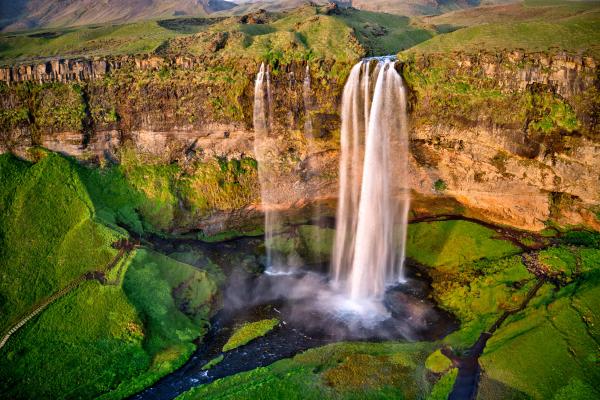
13. Brúarfoss
In the heart of the Golden Circle, not far from Reykjavik, we can find Brúarfoss, often called the “hidden gem” of Iceland. Although it’s not a huge waterfall, its secluded location and blue waters, in contrast with the black rocks and green fields, have made it one of the favorite spots in the country.
What attracts people the most about this place is the multiple cascades that make up Brúarfoss. In contrast to other more famous waterfalls, Bruarfoss tends to be less crowded.

14. Fjallabak Nature Reserve
This area is known for its rugged beauty and striking landscapes. Located in the Central Highlands, one of the most remote regions in Iceland, Fjallabak features colorful rhyolite mountains, geothermal hot springs, and dramatic lava fields. It’s a paradise for hikers, with the famous Laugavegur Trail being the most famous of all the hikes.
Not many tourists make the trip to Fjallabak. This untouched wilderness seems like a place from another world, with its unique combination of vibrant colors and barren fields.
15. Katla Ice Cave
The Katla Ice Cave is one of those experiences, like many others in Iceland, that feels straight out of a dream. Hidden beneath the Katla volcano, this cave is shaped by glacier water, with walls of deep blue ice and stripes of black volcanic ash.
The cave can be visited, and when you go in, you’re quickly surrounded by a surreal mix of colors and textures. The most surprising feature, unlike other ice caves, is the layers of ash.

16. Reynisfjara Beach
Iceland is known around the world for its black sand beaches, and Reynisfjara is probably the most famous of them all. It’s, in fact, the most photographed beach in the country. The color of the beach and the astonishing basalt formations create a sight that often leaves visitors speechless.
In front of Reynisfjara Beach, you'll see the Reynisdrangar rocks. Local folklore says they are trolls turned to stone. One has to be careful when walking on this beach, as the waves and currents are especially strong here.

17. The Westman Islands (Vestmannaeyjar)
The Westman Islands – Vestmannaeyjar in Icelandic – is a group of islands in the south of Iceland that form a special region. It offers a unique mix of natural beauty, wildlife, and history. The main island, Heimay, was reshaped in 1973 by the eruption of the Eldfell volcano. One of the top attractions is the chance to see puffins, as the islands host the largest Atlantic puffin colony in the world.
The main island is also home to Halldórsskora, also known as the Elephant Rock. This formation resembles an elephant that is drinking water from the sea.
Boat tours around the islands give you a chance to see whales, seabirds, and the stunning coastal landscape. The islands are accessible by ferry from the mainland, making them an easy addition to your Iceland itinerary.
18. Landmannalaugar
Landmannalaugar is a stunning geothermal area located in the Central Highlands. It’s known for its colorful rhyolite mountains, geothermal hot springs, and diverse hiking trails. There are options for all kinds of levels, ranging from short, easy walks to more challenging treks.
One popular trail is Blahnúkúr (Blue Peak), which offers breathtaking views of the region. For a more challenging adventure, a good option is the Brennisteinsalda loop, a longer hike that takes you through lava fields and steaming geothermal features. After hiking, you can relax in the natural hot springs that can be found in the area.

19. Laki Craters
Laki Craters, or Lakagígar, is a chain of volcanic craters formed during a massive eruption in 1783-1784, one of the largest in recorded history. This eruption had effects all over Europe, influencing climate and agriculture across the continent. Today, visitors can explore this unique landscape of craters, lava fields, and moss-covered terrain.
The best way to experience Laki Craters is by hiking up Mount Laki, which offers incredible panoramic views of the entire crater chain. The area is remote, accessible only by F-roads, requiring a 4x4 vehicle due to rough roads and river crossings. Visitors are rewarded with the surreal beauty of the landscape and the peaceful isolation of this natural wonder.
Nearby, Fagrifoss Waterfall and Tjarnargígur Lake add even more charm to the visit.
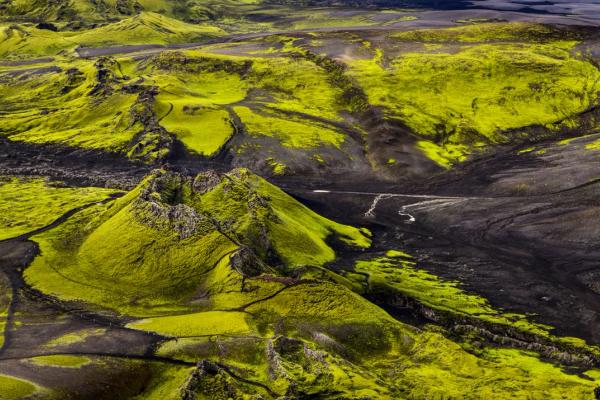
20. Hvítserkur
This rock formation, located off the coast of North Iceland, is one of the most sought-after and photographed natural monuments in the country. Hvítserkur a 15-meter-high (49 feet) basalt formation that arises from the sea. It resembles a dragon that is drinking water from the ocean.
This area is a great place to see seals. Many people also come here trying to encounter the Northern Lights. In winter, the clear skies in the north provide more opportunities to see them, and the look they get in combination with the rock formation is unbeatable.

Conclusion: A natural museum
As we have seen, there are so many amazing natural attractions in Iceland that it’s a bit tricky to choose what to see. If it’s your first time visiting the country, you’ll try to fit as many as you can in your itinerary, but seeing it all can be impossible.
The good news is that no matter what you choose, you’ll make no mistakes. Everything’s astonishing here, and we’re sure you’ll come back for second helpings.










